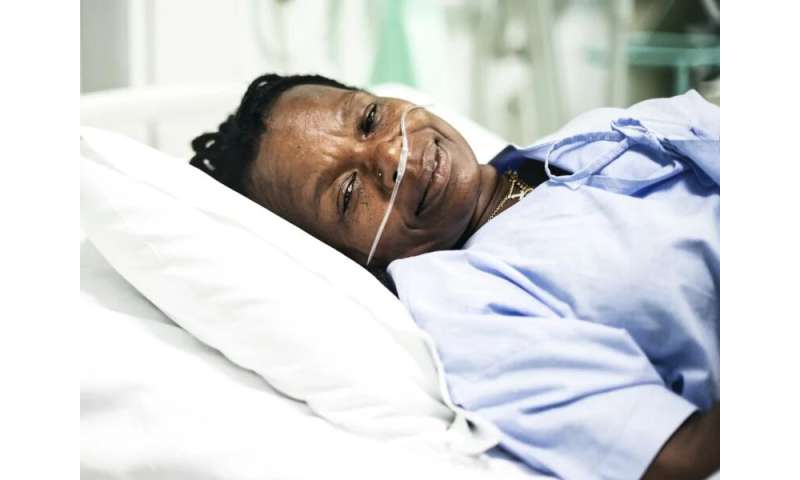Why are blacks, other minorities hardest hit by COVID-19?

(HealthDay)—The new coronavirus is disproportionately striking minority populations—particularly urban blacks and Navajo Indians living on their reservation. Experts say social and economic factors that predate the COVID-19 crisis may help explain why.
“We found that there were large disparities in the proportion of people at risk of COVID-19 from minority and low-income populations,” said study co-author Julia Raifman. She’s an assistant professor of health law, policy and management at the Boston University School of Public Health.
Raifman believes decades of disparities in education, housing, jobs and stress levels have contributed to an excess risk of chronic disease based on race, ethnicity and income. And those same issues are exacerbating the COVID-19 crisis.
Dr. Gary LeRoy is president of the American Academy of Family Physicians. He said the “COVID pandemic has really shined a spotlight on the discrepancies in health care outcomes for people of color and of lower socioeconomic status, and this study raises some very valid points about those discrepancies.”
Looking at the numbers
In New York, blacks make up 33% of COVID-19 hospitalizations. Yet black people are just 18% of the state’s population, according to the U.S. Centers for Disease Control and Prevention. Early data from New York City suggests that blacks are twice as likely to die from COVID-19 as whites are. The CDC also reported that, in New York City, death rates are significantly higher for Hispanics/Latinos than for whites.
Other areas hard-hit by COVID-19 have seen similar trends in deaths for black people. Louisiana’s population is about one-third black, but about 70% of COVID-19 deaths occurred in blacks, according to The New York Times. In Illinois, 15% of the population is black, but 43% of those who died from COVID-19 were black. Michigan’s population is about 14% black, yet black people accounted for 40% of that state’s COVID-19 deaths.
The Navajo Nation has a population of less than 300,000 people in New Mexico, Arizona and Utah. ABC News reported that while Native Americans make up just 5% of New Mexico’s population, they represent 20% of the state’s COVID-19 cases.
Income seems key
Raifman’s study looked at the prevalence of COVID-19 risk factors, such as asthma, heart disease and diabetes. The researchers reviewed 2018 data including over 330,000 people from a nationally representative group.
The researchers then estimated that 43% of American adults have at least one COVID-19 risk factor. That’s about 97 million people. Around 18% have two or more risk factors, which is about 40 million people.
When the investigators looked at those under 65, they found at least one risk factor in: 33% of black adults; 42% of Native American adults; and 27% of white adults.
Only 8% of white adults had multiple risk factors compared to 11% of black adults and 18% of Native American adults.
The stark racial differences were also found in the 65-and-older group.
The researchers found that in people under 65, low-income adults were almost twice as likely to have one or more risk factors as high-income adults. Those with low incomes were more than twice as likely to have multiple risk factors.
The study authors noted that other inequities—such as living in crowded, multigenerational homes, working in a service industry in a job that cannot be done remotely and needing to use public transportation to get to work—can contribute to a higher risk of COVID-19.
An important factor contributing to infections for the Navajo Nation is that about 30% of homes on the reservation don’t have running water, which makes regular hand-washing a challenge, the ABC News report said.
LeRoy, who was not involved in the new study, noted that lack of access to health care has likely played a role, too. In the early stages of the COVID-19 pandemic, people couldn’t easily access a test without a doctor’s referral. That meant someone would need to pay for a doctor’s visit, get a referral and then go for testing, likely incurring more cost. And even if they found out they had the virus, they might not have been able to quarantine effectively if they lived in a crowded home.
“We can’t just snap our fingers and make everyone have the resources to shelter-in-place effectively,” LeRoy said. He added that he doesn’t expect there will be any quick fixes for these long-term problems.
Working conditions are a crucial factor in health disparities, LeRoy added. Many people of color or with lower incomes work in service-industry jobs that require close contact with others, such as nursing home aides. Industrial jobs can also keep people in close contact, he said, and pointed to the high rates of infections in people working in meat-processing plants.
Looking to the future
“I hope we emerge from this pandemic as a smarter global community, but we have to address these glaring health discrepancies,” LeRoy said. One place to start might be making antibody testing more widely available. Antibody tests can show whether or not you’ve had the COVID-19 infection, but it’s not yet clear if that also means that you cannot be reinfected. He said the test is available in some areas, but may not be easily accessible for some, and the cost is $65.
“You don’t need a doctor’s referral for this test, but a lot of people can’t pay the $65,” LeRoy said.
Raifman said that as cities, counties and states start to think about reopening their economies, “it’s important to think about how we’re all interconnected. Policies that protect minorities and people with low incomes help protect everyone. If we can prevent illness in communities that are high risk, I think it will prevent overall deaths and we can feel more comfortable opening up the economy, too.”
Source: Read Full Article


